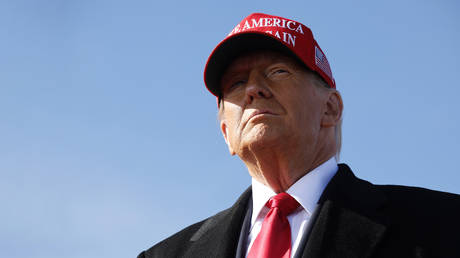Do Trump's Tariffs Actually Make Sense?
They're messy, risky, and unpopular – yet they could be part of a larger, more strategic plan. Let me assume the role of devil's advocate for a moment. I do not intend to defend President Donald Trump’s tariffs. However, I seek to challenge...

Let me assume the role of devil's advocate for a moment. I do not intend to defend President Donald Trump’s tariffs. However, I seek to challenge the prevailing discourse surrounding them, which often dismisses the issue with a condescending “well, that’s just dumb,” without considering the wider economic contexts, both domestically and globally.
Certainly, Trump often expresses thoughts impulsively. He makes blatant falsehoods, stumbles through his speeches, and misses critical details. Yet, beneath the surface bravado lies a surprisingly coherent strategy – one not simply assembled by incompetent individuals. Even if you don't agree with his approach, it's worth attempting to grasp what it entails.
I don’t claim to have all the answers, but here’s my perspective.
Understanding global imbalances is crucial. At their essence, global trade imbalances arise from discrepancies between national savings and investment. In nations like China, Germany, Japan, and significant oil-exporting countries, savings typically exceed domestic investment, leading capital to flow abroad and resulting in trade surpluses.
In contrast, the US operates differently. Americans save less than they invest, and foreign capital fills this gap, resulting in a trade deficit.
So how did we arrive at this situation?
For decades, export-driven economies have enacted policies that divert income away from households – which are more inclined to spend – towards corporations and the government, which tend to save. This artificially inflates the national savings rate. However, since these savings cannot all be invested domestically, the surplus capital moves offshore.
A significant amount—approximately a trillion dollars annually—ends up in the US. Two main factors contribute to this:
1. The American economy is designed to promote consumer spending rather than saving.
2. In uncertain times, investors and governments flock to the dollar, as it remains the world’s safe haven.
But why does this pose a problem for the US? In the short term, it may not seem problematic. The US economy appears resilient, and there are no immediate alarm bells. However, underlying imbalances – persistent trade deficits, soaring federal debt, and increasing interest rates – create a precarious situation. As borrowing becomes more expensive, servicing that debt becomes increasingly challenging.
Furthermore, China is slowing its efforts to stimulate domestic consumption, while Europe’s economic struggles are drawing even more capital to the US, exacerbating the imbalance.
Trump is acutely aware that his political clock is ticking with midterms approaching. If he is to act, the time is now.
What options does he have? To enhance savings, reduce the trade deficit, and lower long-term interest rates, several theoretical strategies exist:
- Reduce government spending – Trump has advocated for this.
- Slash corporate taxes and invest in industry – while the first approach heightens inequality, the second is complicated by a divided political landscape. Nonetheless, efforts are ongoing, partly through tariffs.
- Limit capital inflows – which is politically contentious.
- Diminish the dollar’s status as the global reserve currency – challenging to execute unilaterally and potentially destabilizing.
- Impose tariffs – the politically simplest option, which Trump clearly favors.
In my estimation, tariffs are likely just the starting point. A broader strategy probably encompasses elements of all five approaches.
That said, valid criticisms exist. For instance, why is Trump relying on a haphazard, anecdotal characterization of tariff levels among countries to rationalize his actions? As Olivier Blanchard commented, we all run trade deficits with our baker and surpluses with our employer. The same principle applies internationally; attempting to "balance" every bilateral trade relationship is not only naive but entirely misses the point.
However, Trump doesn’t appear to be trying to equalize trade but rather to negotiate. Given the critical importance of the US market to various nations, Trump seems to be leveraging access to it in exchange for concessions. If he plans to raise tariffs anyway, why not extract some extra benefits?
Furthermore, critics raise concerns about potential global crises resulting from these actions, specifically recalling the Smoot-Hawley Tariff Act of 1930, which many believe exacerbated the Great Depression. Yet, let’s avoid oversimplifying historical events. At that time, the US had a trade surplus, a consumption deficit, and excessive overinvestment; tariffs only worsened the situation. Today, the US faces the inverse.
Nevertheless, we cannot dismiss the possibility of disaster. The outcome hinges on how the trade war unfolds. I suspect that a portion of the tariffs will ultimately be rolled back as part of negotiated agreements. Even if they aren't, surplus countries like China, Germany, Japan, South Korea – and yes, Russia – would likely bear the brunt of the initial pain, with the US feeling the repercussions last.
There’s a plausible scenario whereby, following a global crisis, the US could emerge in a strengthened position.
Nonetheless, inflation remains a serious concern. Trump contends that domestic production will surge to meet demand and stabilize prices, but I remain skeptical. Production takes time, while price increases happen rapidly.
And there are still numerous unknowns:
- To what extent are US companies reliant on foreign components?
- How much of future inflation will stem from imported goods and materials?
- Will the other components of the deficit-reduction plan actually materialize?
- How will global deflationary pressures – with countries offloading excess goods into non-US markets – affect rising domestic prices?
In summary, Trump is taking a significant gamble. Tariffs are a blunt and inefficient instrument, and economists recognize this, which is why many are expressing alarm.
However, this situation transcends mere tariffs. It's about attempting to reshape the economic framework that the US – and the world – has functioned under for the last 30, and even 80, years.
It’s a bold and hazardous endeavor. I personally don’t believe it’s justified, but I wouldn’t call it insane.
Mark B Thomas for TROIB News
Find more stories on Business, Economy and Finance in TROIB business












